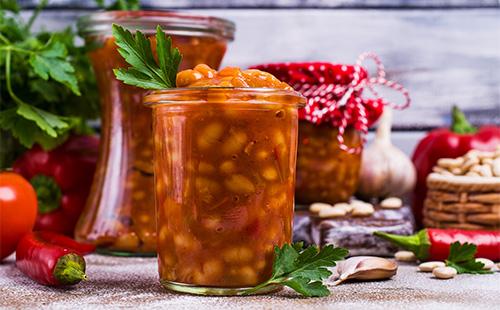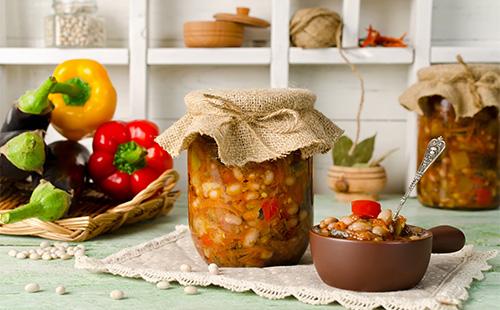Already in the 5th century BC. e. Mexico and the Americas cultivated bean plantations. Columbus brought the seeds of legumes to Europe, but the culture was then grown only as a decorative climbing plant. They also ground it into flour and made whitening for the face.
Only closer to the end of the 17th century, the French physician Geoffrey explained in his writings the beneficial properties of this plant, and mankind finally “tasted” the beans. In our country, the product came in the XVII-XVIII centuries under the appropriate name - French beans.
Benefit
The value of the product is due to its rich chemical composition. In addition to protein, it differs in the following substances.
- Vitamins. E, PP and almost the entire spectrum of the B-group. They are necessary to ensure the transmission of nerve impulses, the production of a sufficient amount of hemoglobin, visual acuity, the beauty of the skin, hair and nails, the regulation of blood sugar and cholesterol, and the strengthening of the walls of blood vessels.
- Macronutrients. Potassium, calcium, phosphorus, silicon, sulfur, sodium, chlorine, magnesium. They are important for bones, heart, nervous system, metabolic processes.
- Trace elements. Iodine, iron, fluorine, chromium, zinc, cobalt, copper, manganese, selenium. Moreover, the concentration of iron in 100 g of the product is almost 33% of the daily human needs.
- Amino acids. Interchangeable and irreplaceable. Without them, the process of synthesis of proteins and hormones is impossible. Amino acids fight cell aging, strengthen the ligamentous apparatus, maintain the elasticity of the skin and blood vessels, normal brain function and reproductive function in both sexes.
Product selection and preparation
At the stage of preparation for preserving beans, it is important to consider three tips.
- Grade. White beans boil faster, taste softer and more suitable for use in first courses. Red - has a denser structure, so it cooks longer, keeps its shape better and looks more attractive in second courses, salads, as a side dish.
- The size. Beans should be about the same size. Otherwise, the small ones will cook faster and turn into porridge, while the large ones will just get to the right condition.
- Soak. This is a required item. Raw beans contain toxic substances and must be removed. Soak white grains for at least six hours, colored - at least eight.
Recipe Selection
There are not so many ways to harvest beans in grains: you can roll it in your own juice, with herbs or vegetables, in tomato sauce. The most common recipes are described below.
In tomato sauce
Ingredients:
- grains of red beans (can be replaced with white) - one glass;
- tomatoes - four pieces (medium size);
- sunflower oil - 50 ml;
- vinegar 9% - 10 ml;
- sugar - 10 g;
- salt - 15 g.
Step by step
- Pour the beans overnight with cool water.
- Boil it.
- Place tomatoes in a colander.
- Add boiling water.
- Peel.
- Grind in a convenient way.
- Boil the resulting tomato sauce.
- Enter all but the beans.
- Boil again.
- Add boiled beans.
- Boil for half an hour over low heat.
- Pour into sterile jars and roll up.
With vegetables
Ingredients:
- bean grains (any) - three glasses;
- tomatoes - 1.5 kg;
- onions - 0.5 kg;
- carrots - three large root crops;
- sweet pepper of any color - 1 kg;
- vegetable oil - 100 ml;
- salt - two tablespoons;
- vinegar 9% - 50 ml;
- sugar - 200 g.
Step by step
- Soak the beans until morning.
- Cook until cooked.
- Cut carrots, onions and peppers into small pieces.
- Crank in a meat grinder.
- Immediately put together with the oil in a large pan and boil for about ten minutes.
- Scale the tomatoes and remove the peel.
- Also rotate in a meat grinder.
- Add tomato puree and bulk ingredients to a common pot.
- Boil another quarter hour over low heat.
- Add boiled beans.
- Stew for 45-50 minutes under the lid.
- Enter vinegar five minutes before ready.
- Roll up in a sterile container.

In own juice
Ingredients:
- bean grains (any) - 0.5 kg;
- water - four glasses;
- salt - two tablespoons;
- sugar - two tablespoons;
- 9% vinegar - 2.5 tablespoons.
Step by step
- Soak the beans for at least eight hours, or better - overnight.
- Drain the water.
- Rinse the product under the tap.
- Pour four glasses of fresh water.
- Pour sugar and cook under the lid for about an hour. (You need to cook on low heat and always with a lid closed so that the water evaporates as slowly as possible. You can’t add water during the cooking process. You can add bay leaf or ground black pepper to your taste if you wish).
- Five to seven minutes before the end, add salt and vinegar.
- Arrange the beans in washed jars, cover and send for sterilization for 20 minutes.
With tomato paste
Ingredients:
- bean grains (any) - 1 kg;
- carrots - three large root crops;
- two onions;
- tomato paste - half a glass;
- vegetable oil - half a glass;
- sugar - 10 g;
- salt - 10 g;
- water - four glasses.
Step by step
- Soak the beans overnight.
- Rinse under the tap.
- Pour four glasses of water, add sugar.
- Stew under the lid for ten minutes.
- Grate the carrots, chop the onions arbitrarily.
- Fry in vegetable oil.
- Pour into the vegetables soup ladle broth from beans, add tomato paste.
- And boil for five to ten minutes.
- Combine both masses and salt.
- Boil over low heat for another ten minutes.
- Put it in banks.
- Cover with lids.
- Sterilize in a large saucepan for at least 25-30 minutes.
- Roll up the lids and cool the jars under the covers.

With greens
Ingredients:
- bean grains (any) - 1 kg;
- tomatoes - 1 kg;
- dill and parsley - two large bunches;
- salt - half a glass;
- ground black pepper - to taste.
Step by step
- Soak the beans overnight.
- Boil until tender.
- Scale the tomatoes and peel them.
- Grind in a blender or in a meat grinder.
- Grind greens not too large.
- Combine all the ingredients in a large saucepan.
- Arrange in clean jars, cover and sterilize for about an hour and a half.
- Roll up the covers.
You can sterilize in a household autoclave. In this case, leave 2-3 cm of free space under the covers, and roll the covers themselves with a key. Cooking time will be reduced to 40-60 minutes depending on the size of the container.

